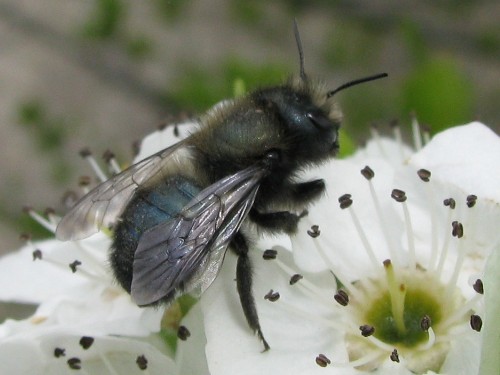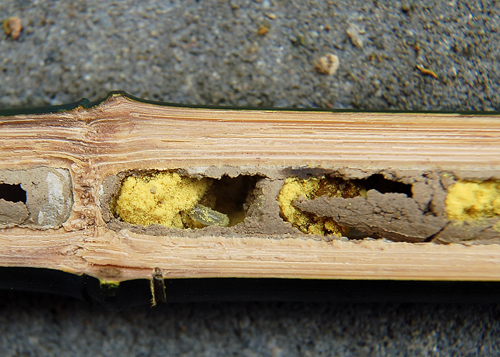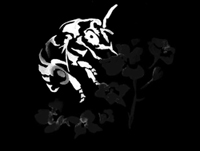Blue orchard bee (Osmia lignaria Fab.)

Photo by (Algidus)
The blue orchard bee is a member of the leafcutter bee family (Megachilidae). Leafcutter bees construct cells and lay eggs within cavities, such as holes in wood or hollow twigs. Most species in the family build individual cells out of pieces of cut leaves, but the blue orchard bee and other members of the genus Osmia use mud, sometimes mixed with chewed leaves or other materials, to build their cells. Because of this, they are often referred to as mason bees rather than leafcutter bees.
The blue orchard bee is solitary and does not form colonies of any kind. However, it is willing to nest in aggregations, which means it can be collected and reared on a commercial scale.
The blue orchard bee is active in the spring and early summer and forages well in inclement weather. This makes it an excellent pollinator of tree fruit. Only a few hundred female orchard bees are needed to pollinate an acre of orchard, as has been demonstrated in cherry and apple. The blue orchard bee has been considered for use in other early-blooming crops, but because it prefers foraging in trees, its potential may be limited.
Mason bees can be purchased as pupae from a commercial supplier, or wild residents can be encouraged by providing appropriate nesting sites. This includes nest boxes or “domiciles” made of bundles of paper straws, reed or bamboo sections, or wooden blocks with holes drilled into them. It is also helpful to provide a bucket or dish of mud near the domiciles, so that the bees do not need to spend time searching for it elsewhere.
Nest boxes and other domiciles may attract woodpeckers and other birds capable of extracting the larvae. A screen can be placed over the boxes to protect the larvae, although this will make the domiciles less attractive to female bees.
Mason bees are present only in the spring and early summer, but they are active for much longer than the blooming period of most crops. They require resources for several weeks after their crop pollination work is complete if they are to produce a generation the following year. Many so-called "weeds" are excellent sources of pollen and nectar for bees when the orchard crop itself is not in bloom. Planting forage flowers that bloom at an appropriate time is also helpful, and may act to suppress other weeds that may compete with the crop during bloom. More details on how to manage blue orchard bees for pollination can be found in Bosch & Kemp (2001) and Mader et al. (2010).
Availability and price of blue orchard bees varies considerably each year. See Vendors – Managed Pollinators for a list of Canadian providers, and those that will ship to Canada.

An Osmia egg in a cell in a twig nest. Note the pollen provisions (photo by tpjunier)
References
Free, J.B. 1993. Insect Pollination of Crops, 2nd edition. Academic Press.
Bosch, J. & Kemp, W.P. 1999. Exceptional cherry production in an orchard pollinated with blue orchard bees. Bee World 80:163-173.
Bosch, J., Kemp, W.P., & Trostle, G.E. 2006. Bee population returns and cherry yields in an orchard pollinated with Osmia lignaria (Hymenoptera: Megachilidae). Journal of Economic Entomology 99:408-413.
Mader, E., Spivak, M, & Evans, E. 2010. Managing Alternative Pollinators: A Handbook for Beekeepers, Growers, and Conservationists. Natural Resource, Agriculture, and Engineering Service Cooperative Extension, Ithaca NY. 162pp.
Sheffield, C.S., Westby, S.M., Kevan, P.G., & Smith, R.F. 2008a. Winter management options for the orchard pollinator Osmia lignaria Say (Hymenoptera: Megachilidae) in Nova Scotia. Journal of the Entomological Society of Ontario 139:3-18.
Sheffield, C.S., Westby, S.M., Smith, R.F., & Kevan, P.G. 2008b. Potential of bigleaf lupine for building and sustaining Osmia lignaria populations for pollination of apple. Canadian Entomologist 140:589-599.
**For more detailed information and references, download the following: Woodcock, T.S. 2012. Pollination in the agricultural landscape: best management practices for crop pollination. University of Guelph. 113 pp.
